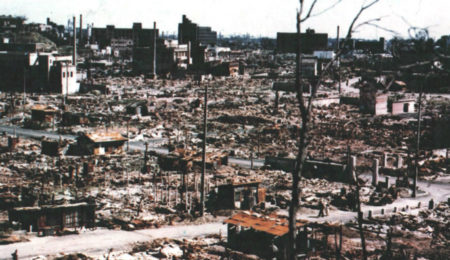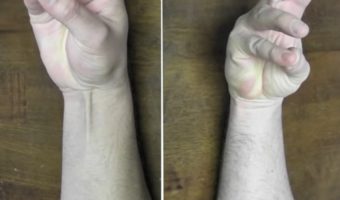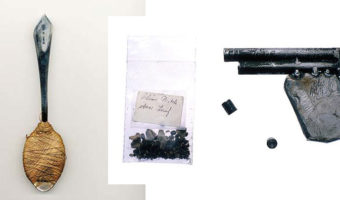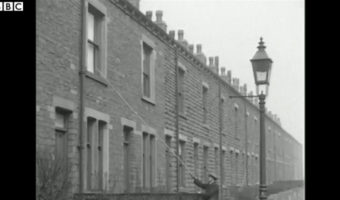24 Distressing Pictures of Hiroshima After the Bombing in 1945

It has been over 70 years since the bombing of Hiroshima, Japan by the United States. On the fateful day of August 6, 1945 at 8:15 AM the uranium-235 isotope atomic bomb, code named Little Boy, was dropped on the city killing as many as 70,000 immediately. 70, 000 more were severely injured and exposed to the deadly radiation, eventually dying within the next five years. Genbaku Dome, a surviving building near ground zero, was named Hiroshima Peace Memorial and made UNESCO World Heritage Site in 1996.
1 The aerial view of Hiroshima before the bombing with densely packed buildings and the river Motoyasu.Image Source: archive.boston.com 2 Hiroshima Prefectural Industrial Promotion Hall, before the bombing, designed by Czech architect Jen Letzel. The building is now Hiroshima Peace Memorial, the most famous landmark of the city.
Image Source: archive.boston.com 3 The map of Hiroshima from US Air Force with circles drawn at 1,000 feet intervals from the target location.
Image Source: archive.boston.com 4 Little Boy being numbered L 11 by Commander A. F. Birch before being loaded into a trailer and later on Enola Gay, the bomber that would drop it over Hiroshima.
Image Source: archive.boston.com 5 View of the explosion of the city from one of the two bombers of US Air Force. The flash of explosion was already over by that time and a shockwave radiated faster than sound.
Image Source: archive.boston.com 6 The mushroom clouds rose above as the uranium bomb underwent fission reactions with the energy of almost 15 kilotons of TNT and a temperature of over 3,900 degrees centigrade.
Image Source: archive.boston.com 7 View of destruction after bombing seen across one of the branches of the river forming a delta at the center of the city.
Image Source: archive.boston.com 8 The Y-shaped intersection of the river branches was the hypocenter, the site directly below the explosion.
Image Source: archive.boston.com 9 A close-up of the bridge at the Y-shaped intersection from the last picture. The shadows of the balustrade where the radiation didn’t touch can still be seen in contrast to the rest of the road that was burnt.
Image Source: archive.boston.com 10 The destroyed building of Okita Iron Works in Hiroshima as seen later in November that year.
Image Source: archive.boston.com 11 A street where the sidewalk was pushed upwards and a drain pipe poked out because of the vacuum created by the pressure of the atomic bomb.
Image Source: archive.boston.com 12 A patient who was 6,500 feet away from ground zero was struck by the radiation on his left side.
Image Source: archive.boston.com 13 Densely packed homes at the edge of severely damaged part of the city, some of which were completely flattened as can be seen at the bottom.
Image Source: archive.boston.com 14 The iron framework remains of a theater at 800 meters from ground zero.
Image Source: archive.boston.com 15 The only ladder truck of Hiroshima Fire Department at 1,200 meters from ground zero.
Image Source: archive.boston.com 16 Aerial view of Hiroshima in the autumn of 1945 with the hypocenter and the Genbaku Dome or A-Bomb Dome visible near the top.
Image Source: archive.boston.com 17 A color photograph of the destruction at the center of the city taken in the autumn of 1945.
Image Source: archive.boston.com 18 A shadow of the hand valve wheel where the radiation couldn’t reach can be seen in contrast with the area around it where the paint had burned away.
Image Source: archive.boston.com 19 The skin of this victim burned in the pattern of the kimono he was wearing at the time of the explosion. The dark portions of the fabric allowed the radiation whereas the rest didn’t.
Image Source: archive.boston.com 20 The keloidal scars formed on the back of this victim on the parts that were directly exposed to radiation.
Image Source: archive.boston.com 21 A man looks at the Genbaku/Atomic Bomb Dome over the extensive ruins and rubble in Hiroshima.
Image Source: archive.boston.com 22 The extent of destruction as viewed from the ruins of Red Cross building less than a mile from the hypocenter.
Image Source: archive.boston.com 23 Aerial view of a destroyed industrial section in Hiroshima.

Image Source: archive.boston.com 24 Two US Army officers examine the area around hypocenter.

Image Source: archive.boston.com

3 The map of Hiroshima from US Air Force with circles drawn at 1,000 feet intervals from the target location.
Image Source: archive.boston.com 4 Little Boy being numbered L 11 by Commander A. F. Birch before being loaded into a trailer and later on Enola Gay, the bomber that would drop it over Hiroshima.
Image Source: archive.boston.com 5 View of the explosion of the city from one of the two bombers of US Air Force. The flash of explosion was already over by that time and a shockwave radiated faster than sound.
Image Source: archive.boston.com 6 The mushroom clouds rose above as the uranium bomb underwent fission reactions with the energy of almost 15 kilotons of TNT and a temperature of over 3,900 degrees centigrade.
Image Source: archive.boston.com 7 View of destruction after bombing seen across one of the branches of the river forming a delta at the center of the city.
Image Source: archive.boston.com 8 The Y-shaped intersection of the river branches was the hypocenter, the site directly below the explosion.
Image Source: archive.boston.com 9 A close-up of the bridge at the Y-shaped intersection from the last picture. The shadows of the balustrade where the radiation didn’t touch can still be seen in contrast to the rest of the road that was burnt.
Image Source: archive.boston.com 10 The destroyed building of Okita Iron Works in Hiroshima as seen later in November that year.
Image Source: archive.boston.com 11 A street where the sidewalk was pushed upwards and a drain pipe poked out because of the vacuum created by the pressure of the atomic bomb.
Image Source: archive.boston.com 12 A patient who was 6,500 feet away from ground zero was struck by the radiation on his left side.
Image Source: archive.boston.com 13 Densely packed homes at the edge of severely damaged part of the city, some of which were completely flattened as can be seen at the bottom.
Image Source: archive.boston.com 14 The iron framework remains of a theater at 800 meters from ground zero.
Image Source: archive.boston.com 15 The only ladder truck of Hiroshima Fire Department at 1,200 meters from ground zero.
Image Source: archive.boston.com 16 Aerial view of Hiroshima in the autumn of 1945 with the hypocenter and the Genbaku Dome or A-Bomb Dome visible near the top.
Image Source: archive.boston.com 17 A color photograph of the destruction at the center of the city taken in the autumn of 1945.
Image Source: archive.boston.com 18 A shadow of the hand valve wheel where the radiation couldn’t reach can be seen in contrast with the area around it where the paint had burned away.
Image Source: archive.boston.com 19 The skin of this victim burned in the pattern of the kimono he was wearing at the time of the explosion. The dark portions of the fabric allowed the radiation whereas the rest didn’t.
Image Source: archive.boston.com 20 The keloidal scars formed on the back of this victim on the parts that were directly exposed to radiation.
Image Source: archive.boston.com 21 A man looks at the Genbaku/Atomic Bomb Dome over the extensive ruins and rubble in Hiroshima.
Image Source: archive.boston.com 22 The extent of destruction as viewed from the ruins of Red Cross building less than a mile from the hypocenter.
Image Source: archive.boston.com 23 Aerial view of a destroyed industrial section in Hiroshima.

Image Source: archive.boston.com 24 Two US Army officers examine the area around hypocenter.

Image Source: archive.boston.com


5 View of the explosion of the city from one of the two bombers of US Air Force. The flash of explosion was already over by that time and a shockwave radiated faster than sound.
Image Source: archive.boston.com 6 The mushroom clouds rose above as the uranium bomb underwent fission reactions with the energy of almost 15 kilotons of TNT and a temperature of over 3,900 degrees centigrade.
Image Source: archive.boston.com 7 View of destruction after bombing seen across one of the branches of the river forming a delta at the center of the city.
Image Source: archive.boston.com 8 The Y-shaped intersection of the river branches was the hypocenter, the site directly below the explosion.
Image Source: archive.boston.com 9 A close-up of the bridge at the Y-shaped intersection from the last picture. The shadows of the balustrade where the radiation didn’t touch can still be seen in contrast to the rest of the road that was burnt.
Image Source: archive.boston.com 10 The destroyed building of Okita Iron Works in Hiroshima as seen later in November that year.
Image Source: archive.boston.com 11 A street where the sidewalk was pushed upwards and a drain pipe poked out because of the vacuum created by the pressure of the atomic bomb.
Image Source: archive.boston.com 12 A patient who was 6,500 feet away from ground zero was struck by the radiation on his left side.
Image Source: archive.boston.com 13 Densely packed homes at the edge of severely damaged part of the city, some of which were completely flattened as can be seen at the bottom.
Image Source: archive.boston.com 14 The iron framework remains of a theater at 800 meters from ground zero.
Image Source: archive.boston.com 15 The only ladder truck of Hiroshima Fire Department at 1,200 meters from ground zero.
Image Source: archive.boston.com 16 Aerial view of Hiroshima in the autumn of 1945 with the hypocenter and the Genbaku Dome or A-Bomb Dome visible near the top.
Image Source: archive.boston.com 17 A color photograph of the destruction at the center of the city taken in the autumn of 1945.
Image Source: archive.boston.com 18 A shadow of the hand valve wheel where the radiation couldn’t reach can be seen in contrast with the area around it where the paint had burned away.
Image Source: archive.boston.com 19 The skin of this victim burned in the pattern of the kimono he was wearing at the time of the explosion. The dark portions of the fabric allowed the radiation whereas the rest didn’t.
Image Source: archive.boston.com 20 The keloidal scars formed on the back of this victim on the parts that were directly exposed to radiation.
Image Source: archive.boston.com 21 A man looks at the Genbaku/Atomic Bomb Dome over the extensive ruins and rubble in Hiroshima.
Image Source: archive.boston.com 22 The extent of destruction as viewed from the ruins of Red Cross building less than a mile from the hypocenter.
Image Source: archive.boston.com 23 Aerial view of a destroyed industrial section in Hiroshima.

Image Source: archive.boston.com 24 Two US Army officers examine the area around hypocenter.

Image Source: archive.boston.com


7 View of destruction after bombing seen across one of the branches of the river forming a delta at the center of the city.
Image Source: archive.boston.com 8 The Y-shaped intersection of the river branches was the hypocenter, the site directly below the explosion.
Image Source: archive.boston.com 9 A close-up of the bridge at the Y-shaped intersection from the last picture. The shadows of the balustrade where the radiation didn’t touch can still be seen in contrast to the rest of the road that was burnt.
Image Source: archive.boston.com 10 The destroyed building of Okita Iron Works in Hiroshima as seen later in November that year.
Image Source: archive.boston.com 11 A street where the sidewalk was pushed upwards and a drain pipe poked out because of the vacuum created by the pressure of the atomic bomb.
Image Source: archive.boston.com 12 A patient who was 6,500 feet away from ground zero was struck by the radiation on his left side.
Image Source: archive.boston.com 13 Densely packed homes at the edge of severely damaged part of the city, some of which were completely flattened as can be seen at the bottom.
Image Source: archive.boston.com 14 The iron framework remains of a theater at 800 meters from ground zero.
Image Source: archive.boston.com 15 The only ladder truck of Hiroshima Fire Department at 1,200 meters from ground zero.
Image Source: archive.boston.com 16 Aerial view of Hiroshima in the autumn of 1945 with the hypocenter and the Genbaku Dome or A-Bomb Dome visible near the top.
Image Source: archive.boston.com 17 A color photograph of the destruction at the center of the city taken in the autumn of 1945.
Image Source: archive.boston.com 18 A shadow of the hand valve wheel where the radiation couldn’t reach can be seen in contrast with the area around it where the paint had burned away.
Image Source: archive.boston.com 19 The skin of this victim burned in the pattern of the kimono he was wearing at the time of the explosion. The dark portions of the fabric allowed the radiation whereas the rest didn’t.
Image Source: archive.boston.com 20 The keloidal scars formed on the back of this victim on the parts that were directly exposed to radiation.
Image Source: archive.boston.com 21 A man looks at the Genbaku/Atomic Bomb Dome over the extensive ruins and rubble in Hiroshima.
Image Source: archive.boston.com 22 The extent of destruction as viewed from the ruins of Red Cross building less than a mile from the hypocenter.
Image Source: archive.boston.com 23 Aerial view of a destroyed industrial section in Hiroshima.

Image Source: archive.boston.com 24 Two US Army officers examine the area around hypocenter.

Image Source: archive.boston.com


9 A close-up of the bridge at the Y-shaped intersection from the last picture. The shadows of the balustrade where the radiation didn’t touch can still be seen in contrast to the rest of the road that was burnt.
Image Source: archive.boston.com 10 The destroyed building of Okita Iron Works in Hiroshima as seen later in November that year.
Image Source: archive.boston.com 11 A street where the sidewalk was pushed upwards and a drain pipe poked out because of the vacuum created by the pressure of the atomic bomb.
Image Source: archive.boston.com 12 A patient who was 6,500 feet away from ground zero was struck by the radiation on his left side.
Image Source: archive.boston.com 13 Densely packed homes at the edge of severely damaged part of the city, some of which were completely flattened as can be seen at the bottom.
Image Source: archive.boston.com 14 The iron framework remains of a theater at 800 meters from ground zero.
Image Source: archive.boston.com 15 The only ladder truck of Hiroshima Fire Department at 1,200 meters from ground zero.
Image Source: archive.boston.com 16 Aerial view of Hiroshima in the autumn of 1945 with the hypocenter and the Genbaku Dome or A-Bomb Dome visible near the top.
Image Source: archive.boston.com 17 A color photograph of the destruction at the center of the city taken in the autumn of 1945.
Image Source: archive.boston.com 18 A shadow of the hand valve wheel where the radiation couldn’t reach can be seen in contrast with the area around it where the paint had burned away.
Image Source: archive.boston.com 19 The skin of this victim burned in the pattern of the kimono he was wearing at the time of the explosion. The dark portions of the fabric allowed the radiation whereas the rest didn’t.
Image Source: archive.boston.com 20 The keloidal scars formed on the back of this victim on the parts that were directly exposed to radiation.
Image Source: archive.boston.com 21 A man looks at the Genbaku/Atomic Bomb Dome over the extensive ruins and rubble in Hiroshima.
Image Source: archive.boston.com 22 The extent of destruction as viewed from the ruins of Red Cross building less than a mile from the hypocenter.
Image Source: archive.boston.com 23 Aerial view of a destroyed industrial section in Hiroshima.

Image Source: archive.boston.com 24 Two US Army officers examine the area around hypocenter.

Image Source: archive.boston.com


11 A street where the sidewalk was pushed upwards and a drain pipe poked out because of the vacuum created by the pressure of the atomic bomb.
Image Source: archive.boston.com 12 A patient who was 6,500 feet away from ground zero was struck by the radiation on his left side.
Image Source: archive.boston.com 13 Densely packed homes at the edge of severely damaged part of the city, some of which were completely flattened as can be seen at the bottom.
Image Source: archive.boston.com 14 The iron framework remains of a theater at 800 meters from ground zero.
Image Source: archive.boston.com 15 The only ladder truck of Hiroshima Fire Department at 1,200 meters from ground zero.
Image Source: archive.boston.com 16 Aerial view of Hiroshima in the autumn of 1945 with the hypocenter and the Genbaku Dome or A-Bomb Dome visible near the top.
Image Source: archive.boston.com 17 A color photograph of the destruction at the center of the city taken in the autumn of 1945.
Image Source: archive.boston.com 18 A shadow of the hand valve wheel where the radiation couldn’t reach can be seen in contrast with the area around it where the paint had burned away.
Image Source: archive.boston.com 19 The skin of this victim burned in the pattern of the kimono he was wearing at the time of the explosion. The dark portions of the fabric allowed the radiation whereas the rest didn’t.
Image Source: archive.boston.com 20 The keloidal scars formed on the back of this victim on the parts that were directly exposed to radiation.
Image Source: archive.boston.com 21 A man looks at the Genbaku/Atomic Bomb Dome over the extensive ruins and rubble in Hiroshima.
Image Source: archive.boston.com 22 The extent of destruction as viewed from the ruins of Red Cross building less than a mile from the hypocenter.
Image Source: archive.boston.com 23 Aerial view of a destroyed industrial section in Hiroshima.

Image Source: archive.boston.com 24 Two US Army officers examine the area around hypocenter.

Image Source: archive.boston.com


13 Densely packed homes at the edge of severely damaged part of the city, some of which were completely flattened as can be seen at the bottom.
Image Source: archive.boston.com 14 The iron framework remains of a theater at 800 meters from ground zero.
Image Source: archive.boston.com 15 The only ladder truck of Hiroshima Fire Department at 1,200 meters from ground zero.
Image Source: archive.boston.com 16 Aerial view of Hiroshima in the autumn of 1945 with the hypocenter and the Genbaku Dome or A-Bomb Dome visible near the top.
Image Source: archive.boston.com 17 A color photograph of the destruction at the center of the city taken in the autumn of 1945.
Image Source: archive.boston.com 18 A shadow of the hand valve wheel where the radiation couldn’t reach can be seen in contrast with the area around it where the paint had burned away.
Image Source: archive.boston.com 19 The skin of this victim burned in the pattern of the kimono he was wearing at the time of the explosion. The dark portions of the fabric allowed the radiation whereas the rest didn’t.
Image Source: archive.boston.com 20 The keloidal scars formed on the back of this victim on the parts that were directly exposed to radiation.
Image Source: archive.boston.com 21 A man looks at the Genbaku/Atomic Bomb Dome over the extensive ruins and rubble in Hiroshima.
Image Source: archive.boston.com 22 The extent of destruction as viewed from the ruins of Red Cross building less than a mile from the hypocenter.
Image Source: archive.boston.com 23 Aerial view of a destroyed industrial section in Hiroshima.

Image Source: archive.boston.com 24 Two US Army officers examine the area around hypocenter.

Image Source: archive.boston.com


15 The only ladder truck of Hiroshima Fire Department at 1,200 meters from ground zero.
Image Source: archive.boston.com 16 Aerial view of Hiroshima in the autumn of 1945 with the hypocenter and the Genbaku Dome or A-Bomb Dome visible near the top.
Image Source: archive.boston.com 17 A color photograph of the destruction at the center of the city taken in the autumn of 1945.
Image Source: archive.boston.com 18 A shadow of the hand valve wheel where the radiation couldn’t reach can be seen in contrast with the area around it where the paint had burned away.
Image Source: archive.boston.com 19 The skin of this victim burned in the pattern of the kimono he was wearing at the time of the explosion. The dark portions of the fabric allowed the radiation whereas the rest didn’t.
Image Source: archive.boston.com 20 The keloidal scars formed on the back of this victim on the parts that were directly exposed to radiation.
Image Source: archive.boston.com 21 A man looks at the Genbaku/Atomic Bomb Dome over the extensive ruins and rubble in Hiroshima.
Image Source: archive.boston.com 22 The extent of destruction as viewed from the ruins of Red Cross building less than a mile from the hypocenter.
Image Source: archive.boston.com 23 Aerial view of a destroyed industrial section in Hiroshima.

Image Source: archive.boston.com 24 Two US Army officers examine the area around hypocenter.

Image Source: archive.boston.com


17 A color photograph of the destruction at the center of the city taken in the autumn of 1945.
Image Source: archive.boston.com 18 A shadow of the hand valve wheel where the radiation couldn’t reach can be seen in contrast with the area around it where the paint had burned away.
Image Source: archive.boston.com 19 The skin of this victim burned in the pattern of the kimono he was wearing at the time of the explosion. The dark portions of the fabric allowed the radiation whereas the rest didn’t.
Image Source: archive.boston.com 20 The keloidal scars formed on the back of this victim on the parts that were directly exposed to radiation.
Image Source: archive.boston.com 21 A man looks at the Genbaku/Atomic Bomb Dome over the extensive ruins and rubble in Hiroshima.
Image Source: archive.boston.com 22 The extent of destruction as viewed from the ruins of Red Cross building less than a mile from the hypocenter.
Image Source: archive.boston.com 23 Aerial view of a destroyed industrial section in Hiroshima.

Image Source: archive.boston.com 24 Two US Army officers examine the area around hypocenter.

Image Source: archive.boston.com


19 The skin of this victim burned in the pattern of the kimono he was wearing at the time of the explosion. The dark portions of the fabric allowed the radiation whereas the rest didn’t.
Image Source: archive.boston.com 20 The keloidal scars formed on the back of this victim on the parts that were directly exposed to radiation.
Image Source: archive.boston.com 21 A man looks at the Genbaku/Atomic Bomb Dome over the extensive ruins and rubble in Hiroshima.
Image Source: archive.boston.com 22 The extent of destruction as viewed from the ruins of Red Cross building less than a mile from the hypocenter.
Image Source: archive.boston.com 23 Aerial view of a destroyed industrial section in Hiroshima.

Image Source: archive.boston.com 24 Two US Army officers examine the area around hypocenter.

Image Source: archive.boston.com


21 A man looks at the Genbaku/Atomic Bomb Dome over the extensive ruins and rubble in Hiroshima.
Image Source: archive.boston.com 22 The extent of destruction as viewed from the ruins of Red Cross building less than a mile from the hypocenter.
Image Source: archive.boston.com 23 Aerial view of a destroyed industrial section in Hiroshima.

Image Source: archive.boston.com 24 Two US Army officers examine the area around hypocenter.

Image Source: archive.boston.com


23 Aerial view of a destroyed industrial section in Hiroshima.

Image Source: archive.boston.com 24 Two US Army officers examine the area around hypocenter.

Image Source: archive.boston.com


[source:Â archive.boston.com]
You May Also Like
OUR RECENT VIDEOS ![Picture]()
![Picture]()
![Picture]()
![Picture]()
![Picture]()
![Picture]()
![Picture]()
![Picture]()
background
10 of the Weirdest Birds You Never Knew Existed 
background
10 Unbelievable Facts About Space 
background
This Is What Everyday Foods Look Like Before they Are Harvested 
background
The Mysterious Disappearance Of The Sri Lankan Handball Team 
background
How Were Dinosaur Fossils Not Discovered Until The 1800s? 
background
Why Does Time Go Faster As We Grow Older? 
background
Why Aren’t Planes Getting Faster? 
background
10 Events That Can Wipe Out Humanity 
















